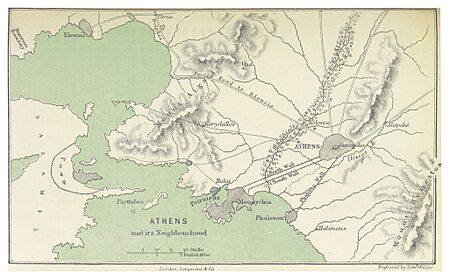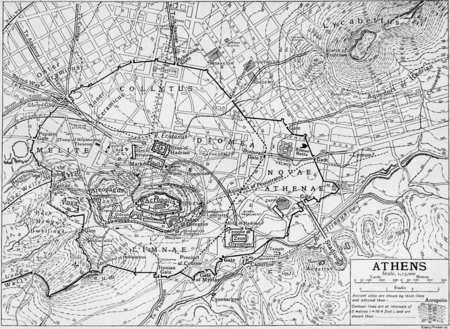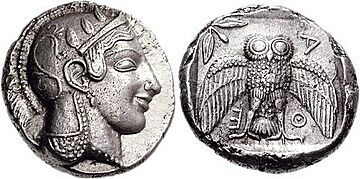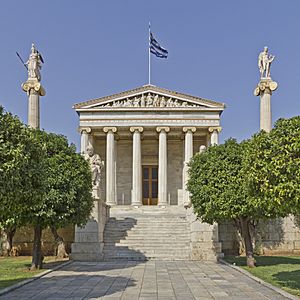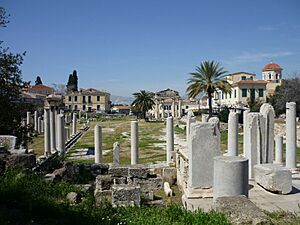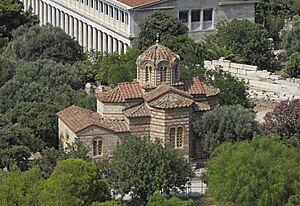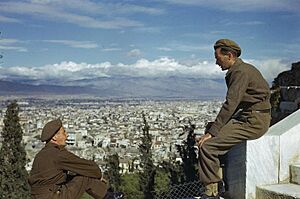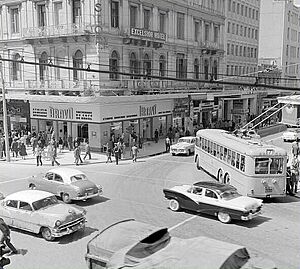History of Athens facts for kids
Quick facts for kids
Athens
Ἀθῆναι
|
|
|---|---|
|
Polis
|
|

Painting of an idealized reconstruction of the Acropolis and Areios Pagos in Athens, by Leo von Klenze (1846)
|
- Kingdom of Athens 1556 BC–1068 BC
- City-state of Athens 1068 BC–322 BC
- Hellenic League 338 BC–322 BC
- Kingdom of Macedonia 322 BC–148 BC
- Roman Republic 146 BC–27 BC
- Roman Empire 27 BC–395 AD
 Eastern Roman Empire 395–1205
Eastern Roman Empire 395–1205 Duchy of Athens 1205–1458
Duchy of Athens 1205–1458 Ottoman Empire 1458–1822, 1827–1832
Ottoman Empire 1458–1822, 1827–1832 Greece 1822–1827, 1832–present
Greece 1822–1827, 1832–present
Athens is one of the oldest cities in the world. People have lived there for about 5,000 years! It's located in southern Europe. In the first 1,000 years BC, Athens became the most important city in Ancient Greece. Its amazing achievements in the 5th century BC helped shape what we call Western civilization today.
During the early Middle Ages, Athens became less important. But it grew stronger again under the later Byzantine Empire. It was quite rich during the time of the Crusades (12th and 13th centuries) because of trade with Italy. After a tough period under the Ottoman Empire, Athens became the capital of the independent Greek state in the 1800s.
Contents
- The Name of Athens: A Mythical Story
- Where is Ancient Athens Located?
- Athens Through Time: A Journey Through History
- Athens in the Middle Ages
- Early Modern Period: Ottoman Rule
- Modern History of Athens
- Ancient Sites to Explore in Athens
- Famous People from Athens
- See also
- Images for kids
The Name of Athens: A Mythical Story
The name of Athens comes from its patron goddess, Athena. The story of how Athens got its name is a famous myth. It tells of a contest between Athena and Poseidon, the god of the sea. Both wanted to be the city's special protector and give it their name.
They each offered the city a gift. Poseidon struck the ground with his trident, and a spring appeared. This symbolized naval power. Athena created the olive tree, which symbolized peace and wealth. The people of Athens, led by their ruler Cecrops, chose the olive tree. So, they named their city after Athena.
A sacred olive tree, believed to be the one Athena created, was still on the Acropolis much later. Even after it was burned during the Persian Wars, a new shoot grew from its stump. The Greeks saw this as a sign that Athena still watched over their city.
Where is Ancient Athens Located?
The Acropolis, which means 'high city', was first settled around 4,000 BC. It was a great spot for defense because it was high up and overlooked the plains around it. Athens is about 20 kilometers (12 miles) from the sea, located in a fertile valley called the Cephisian Plain. Mount Hymettus is to the east and Mount Pentelicus to the north.
Ancient Athens was much smaller than modern Athens. The old walled city was about two kilometers (1.2 miles) wide. Even at its busiest, the city's suburbs didn't go far beyond these walls. The Acropolis was just south of the center of this walled area.
The Agora, which was the city's main market and social hub, was about 400 meters (1,300 feet) north of the Acropolis. Today, this area is known as Monastiraki. The Pnyx hill, where the Athenian Assembly met, was on the western side of the city. The Eridanus river flowed through the city.
Some of the most important religious sites were in Athens. The Parthenon, a temple to Athena, stood on the Acropolis. Its ruins are still there today. The Temple of Hephaestus and the Temple of Olympian Zeus were also inside the city walls. The Temple of Olympian Zeus was once the largest temple in mainland Greece.
Athens Through Time: A Journey Through History
Early History and Mycenaean Times
Athens has been lived in since the Neolithic period, over 5,000 years ago. By 1412 BC, it was an important part of the Mycenaean civilization. The Acropolis was home to a large Mycenaean fortress. You can still see parts of its huge, ancient walls.
Unlike other Mycenaean cities, Athens might not have been destroyed around 1200 BC. This was a time when many cities faced problems, often linked to the Late Bronze Age collapse. Athenians believed they were 'pure' Ionians, not mixed with other groups like the Dorians. However, Athens did face an economic slowdown for about 150 years.
Later, around 900 BC, Athens became a leading center for trade and wealth. This was shown by the rich burials found in places like Kerameikos. Its location, strong Acropolis, and access to the sea gave it an advantage over other cities like Thebes and Sparta.
Founding Myths and Early Rulers
Legend says that Athens was first ruled by kings until about the 9th century BC. These kings were likely leaders of rich families called the Eupatridae. They governed through a council that met on the Hill of Ares, known as the Areopagus. This council chose the city's main officials.
The most famous king of Athens was Theseus, a hero from Greek Mythology who defeated the Minotaur.
Classical Period: The Birth of Democracy
During the first 1,000 years BC, Athens brought other towns in Attica under its control. This process, called synoikismos, made Athens the largest and wealthiest state in mainland Greece. But it also meant more people were left out of political life by the nobles.
By the 7th century BC, there was a lot of social unrest. The Areopagus asked Draco to create strict new laws. When that didn't work, they chose Solon in 594 BC to write a new constitution.
Solon's Reforms and the Path to Democracy
| Didrachm of Athens, 545–510 BC | |
|---|---|
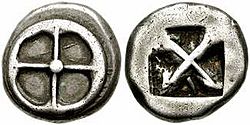 |
|
| Obv: Four-spoked wheel | Rev: Incuse square, divided diagonally |
| Silver didrachm of Athens of heraldic type from the time of Peisistratus, 545–510 BC | |
| Obol of Athens, 545–525 BC | |
|---|---|
 |
|
| Obv: A Gorgoneion | Rev: Square incuse |
| An archaic silver obol of Athens of heraldic type from the time of Peisistratus, 545–525 BC | |
Solon's changes helped both politics and the economy. He reduced the power of the rich families by stopping the practice of enslaving citizens for debt. He also broke up large landholdings and encouraged trade. This helped a new class of wealthy traders emerge.
Politically, Solon divided Athenians into four groups based on their wealth and military service. The poorest group, the Thetai, could vote in the Ecclesia (Assembly) for the first time. However, only the richer classes could hold political jobs. The Areopagus still existed, but with less power.
These changes set the stage for Athenian democracy. But they didn't immediately stop all class conflicts. After 20 years of trouble, a popular leader named Peisistratos took power. He was called a tyrant, but in ancient Greece, this just meant someone who took power by force, not necessarily a cruel ruler. Peisistratos was actually very popular. He made Athens rich, powerful, and a center of culture. He kept Solon's laws but made sure his family held all the important government roles.
Peisistratos also built the first aqueduct tunnel in Athens. This brought water from Mount Hymettos and the Ilissos river to the city. Parts of this old water system can still be seen in some modern metro stations.

Peisistratos died in 527 BC. His sons, Hippias and Hipparchus, took over. They were not as good at ruling. In 514 BC, Hipparchus was killed. This made Hippias rule very strictly, which people disliked. He was overthrown in 510 BC. Then, a politician named Cleisthenes came to power and truly established democracy in Athens.
Cleisthenes changed the old four phyle (tribes) into ten new ones. These new tribes were based on legendary heroes and had no class divisions. Each phyle chose 50 members for the Boule, a council that managed Athens daily. The Assembly was open to all citizens. It acted as both a law-making body and a high court. Only murder cases and religious matters were still handled by the Areopagus.
Most public jobs were chosen by lot, but the ten strategoi (generals) were elected. This system was very stable. It lasted for 170 years, with only a few short breaks. It ended when Philip II of Macedon defeated Athens and Thebes in the Battle of Chaeronea in 338 BC.
Athens' Military and the Persian Wars

Before Athens became powerful, Sparta saw itself as the leader of the Greeks. In 499 BC, Athens sent soldiers to help the Ionian Greeks in Asia Minor. These Greeks were rebelling against the Persian Empire. This led to two Persian invasions of Greece by the Achaemenid Empire.
In 490 BC, the Athenians, led by Miltiades, defeated the first Persian invasion under Darius I at the Battle of Marathon.
In 480 BC, the Persians returned with Darius's son Xerxes. A small Greek force was defeated at Thermopylae. The Persians then captured and looted Athens twice in one year. But the Athenians, led by Themistocles, and their allies, defeated the much larger Persian navy at the Battle of Salamis. This was a major turning point in the war.
In 479 BC, the Athenians, Spartans, and their allies finally defeated the Persian army at the Battle of Plataea. Athens then took the fight to Asia Minor. These victories allowed Athens to unite most of the Aegean region and other parts of Greece into the Delian League. This alliance was mostly controlled by Athens.
The Peloponnesian War and Its Aftermath
Other cities became angry about Athens' power. This led to the Peloponnesian War, which started in 431 BC. Athens and its empire fought against a group of land-based states led by Sparta. The war was long. Sparta was strong on land, while Athens ruled the sea. However, a terrible Sicilian Expedition greatly weakened Athens. The war ended in 404 BC with Athens' defeat after the Battle of Aegospotami, which destroyed Athens' naval power.

Because of how badly the war was handled, democracy in Athens was briefly overthrown in 411 BC. But it was quickly brought back. The war ended in 404 BC with Athens' complete defeat. Since democratic politicians were blamed for the loss, there was a short period against democracy, helped by the Spartan army. This was the rule of the Thirty Tyrants. But in 403 BC, democracy was restored by Thrasybulus, and everyone was forgiven.
Sparta's allies soon turned against it because of its harsh policies. Athens' former enemies, Thebes and Corinth, became its allies. They fought with Athens and Argos against Sparta in the Corinthian War (395 – 387 BC), which didn't have a clear winner. This opposition to Sparta allowed Athens to create a Second Athenian League.
Later, Thebes defeated Sparta in 371 BC at the Battle of Leuctra. But then the Greek cities, including Athens and Sparta, turned against Thebes. Thebes' power ended at the Battle of Mantinea (362 BC) when its brilliant military leader, Epaminondas, died.
Athens and the Rise of Macedon
By the mid-4th century BC, the northern Greek kingdom of Macedon became very powerful. In the Battle of Chaeronea (338 BC), Philip II's armies defeated an alliance of Greek city-states, including Athens and Thebes. This forced them into a confederation and limited Athens' independence.
Later, the conquests of Alexander the Great expanded the Greek world. This made the traditional Greek city-state less important. Athens remained a rich city with a great cultural life, but it was no longer a leading power. The time after Alexander's death in 323 BC is called Hellenistic Greece.
Famous Artists and Thinkers
The period from the end of the Persian Wars to the Macedonian conquest was Athens' golden age for literature, philosophy, and art. During this time, political satire in plays at the theaters greatly influenced what people thought.
Many important figures in Western culture and thought lived in Athens then. These included playwrights like Aeschylus, Sophocles, Euripides, and Aristophanes. There was also the doctor Hippocrates, philosophers Socrates, Plato, and Aristotle. Historians like Herodotus, Thucydides, and Xenophon also lived there. The leading statesman of the mid-fifth century BC was Pericles. He used money from the Delian League to build the Parthenon and other great buildings. Pericles famously called Athens "the school of Hellas [Greece]."
Roman Athens: A City of Learning
After the Pyrrhic War (280–275 BC), Rome became more powerful in Greece. Athens eventually came under Roman rule. During the First Mithridatic War, Athens was ruled by Aristion, a leader put in place by Mithridates the Great. From 88–85 BC, much of Athens' defenses and homes were destroyed by the Roman general Sulla during the Siege of Athens and Piraeus. However, many public buildings and monuments were saved.
The Macedonian astronomer Andronicus designed the Tower of the Winds for the Roman forum, which still stands today. Under Roman rule, Athens was a "free city" because its schools were so admired. The Roman emperor Hadrian (117–138 AD) built the Library of Hadrian, a gymnasium, and an aqueduct that is still used. He also completed the Temple of Olympian Zeus. The Arch of Hadrian celebrates Hadrian's founding of a new part of the city.
In 267 AD, the city was attacked by the Heruli. Many public buildings were burned, and the lower city was looted. After this, Athens was quickly rebuilt with smaller walls around the Acropolis. The Agora was left outside these new walls. Athens remained a center for learning and philosophy for 500 years under Roman rule. Emperors like Nero and Hadrian supported it.
Athens in the Middle Ages
Byzantine Athens: A Changing City
In the early 4th century AD, the eastern Roman empire began to be ruled from Constantinople. Many of Athens' artworks were taken to decorate the new capital. The empire became Christian, and the use of Latin decreased, with Greek becoming the main language. Athens was ruled by emperors until the 13th century. Its citizens saw themselves as part of the Roman Empire.
The change from paganism to Christianity greatly affected Athens. Old monuments like the Parthenon were turned into churches. As the empire became more anti-pagan, Athens became a smaller, less important town. The city was attacked by the Heruli in 267 and by the Visigoths in 396. These attacks greatly damaged the city. Athens was then limited to a small fortified area.
Emperor Justinian I (527–565) banned the teaching of philosophy by pagans in 529. This event is often seen as the end of Athens' ancient history. Athens was attacked by the Slavs in 582, but it remained under imperial control.
The city faced threats from Saracen raids in the 8th and 9th centuries. But there's also evidence of a mosque in the city at that time. Athens supported the use of religious images during the Byzantine Iconoclasm debate. Empress Irene of Athens from Athens helped end the first period of Iconoclasm.
In the 11th and 12th centuries, Athens grew quickly. The old marketplace, the Agora, was built over. The town became important for making soaps and dyes. This growth attracted traders from Venice and other places. This trade further increased the city's wealth.
This period was also a Golden Age for Byzantine art in Athens. Most of the important Middle Byzantine churches in and around Athens were built then. But this prosperity didn't last. In 1204, the Fourth Crusade conquered Athens. The city was not returned to Greek rule until the 19th century.
Latin Athens: Rule by Western Europeans

From 1204 to 1458, Athens was ruled by "Latins" or "Franks". These were Western Europeans who followed the Latin Church and came during the Crusades. Athens became part of a feudal system, similar to the Crusader states in Syria. This time is known as the Frankokratia.
Athens was first the capital of the Duchy of Athens. This duchy was a part of the Latin Empire. Later, Thebes became the capital, but Athens remained an important religious center. Under the Burgundian dukes, a bell tower, known as the Frankish Tower, was added to the Parthenon. The Burgundians brought chivalry and tournaments to Athens and strengthened the Acropolis.
In 1311, Athens was conquered by the Catalan Company, a group of mercenaries. They held the city until 1388. After 1379, Athens became the capital of the duchy again. In 1388, Nerio I Acciajuoli from Florence took the city and became its duke. His family ruled Athens until the Turkish conquest in 1458.
Early Modern Period: Ottoman Rule
Athens Under the Ottoman Empire
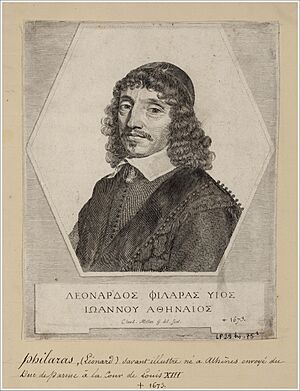
The Ottomans first attacked Athens in 1397. In 1458, Sultan Mehmed II captured Athens. He was impressed by the beauty of its ancient monuments and ordered that they not be looted or destroyed. The Parthenon was turned into the city's main mosque.
Under Ottoman rule, Athens lost much of its importance and its population dropped. It became a "small country town." The Ottomans started storing gunpowder in the Parthenon and Propylaea. In 1640, lightning struck the Propylaea, destroying it. In 1687, during the Morean War, the Acropolis was attacked by the Venetians. A shot caused a powder magazine in the Parthenon to explode, severely damaging the building. This is largely how it looks today.
The Venetians occupied Athens for six months. Both the Venetians and Ottomans looted the Parthenon. One of its western sculptures was removed, causing more damage. In 1688, the Venetians left Athens, and the Ottomans returned.
In the 18th century, the city became more prosperous. By the 1770s, Athens was doing well again. Its Greek population had a lot of self-government. They had a council of leading families and the city's bishop. They were quite influential with the Ottoman rulers. Taxes were also light.
This peaceful time was interrupted in 1752–1753. A new governor, Sari Muselimi, abused his power. The people protested, and he killed some leaders. The people then burned his home. He fled to the Acropolis until order was restored. In 1759, a new governor destroyed a pillar of the Temple of Olympian Zeus to build a mosque. This was illegal, as the temple was the Sultan's property.
The city was then leased out for tax collection. The first owner, Ismail Agha, was kind and popular. English visitors in the 1760s reported about 10,000 people lived there, mostly Christians. The Turkish community had good relations with their Christian neighbors. The city exported leather, soap, grain, oil, honey, and other goods.
Ismail Agha's successor, Hadji Ali Haseki, was cruel. His rule was one of the worst times for the city. He took large sums of money and property from the people. Athenians managed to get him removed several times, but he always returned until his final execution in 1795. Haseki also ordered the building of a new city wall, the "Wall of Haseki", using materials from ancient monuments.
Between 1801 and 1805, Lord Elgin, the British ambassador, removed many sculptures from the Parthenon. These are now known as the Elgin marbles. One of the six caryatids from the Erechtheion was also taken. In total, 50 pieces of sculpture were removed.
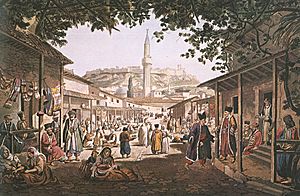
Athens also produced important thinkers during this time. Demetrius Chalcondyles (1423–1511) became a famous teacher of Greek philosophy in Italy. His cousin, Laonicus Chalcondyles (about 1423–1490), was a notable historian. In the 17th century, Leonardos Philaras (about 1595–1673) worked to get support for Greek independence from Western European thinkers.
Independence from the Ottomans
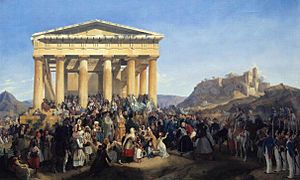
In 1822, Greek rebels captured the city. But it fell back to the Ottomans in 1826. The ancient monuments suffered more damage. The Ottomans stayed until March 1833. At that time, Athens was a small town with about 400 houses, mostly around the Acropolis in the Plaka district.
Modern History of Athens
Athens Becomes the Capital
In 1832, Otto, a prince from Bavaria, became King of Greece. He adopted a Greek name, King Othon. One of his first tasks was to survey Athens, his new capital. He assigned Gustav Eduard Schaubert and Stamatios Kleanthis to this job. At that time, Athens had only 4,000 to 5,000 people. They lived in scattered houses at the foot of the Acropolis, in what is now the Plaka district.
Athens was chosen as the Greek capital for its historical importance. There are few buildings left from the Byzantine Empire or the 18th century. Once it was made the capital, a modern city plan was created, and public buildings were constructed.
The best buildings from this period include the University of Athens (1837), the National Gardens of Athens (1840), the National Library of Greece (1842), the Old Royal Palace (now the Greek Parliament Building; 1843), the Old Parliament Building (1858), the City Hall (1874), the Zappeion Exhibition Hall (1878), the Greek National Academy (1885), and the New Royal Palace (now the Presidential Palace; 1897). Athens also hosted the 1896 Summer Olympics, the first modern Olympic Games.

Athens grew very quickly again after the Greco-Turkish War in 1921. More than a million Greek refugees from Asia Minor moved to Greece after the Asia Minor Catastrophe in 1922. Suburbs like Nea Ionia and Nea Smyrni started as refugee settlements. The city's population doubled.
Athens During World War II
Athens was occupied by the Axis powers (mainly German soldiers) during World War II. The city suffered greatly during the war, especially from the Great Famine. Several resistance groups fought against the occupation in Athens. After Greece was freed and the Greek Civil War began, the Dekemvriana caused heavy fighting in the city. This was between communist forces and government forces, who were supported by the British.
Contemporary Athens: Growth and Modernization
After World War II, Athens started to grow again as people moved from villages and islands to find jobs. When Greece joined the European Union in 1981, a lot of new money came into the city. But this also brought more traffic and air pollution. Athens had some of the worst traffic and air pollution in the world back then. This was a threat to the ancient monuments, as vibrations from traffic weakened foundations and pollution damaged marble.
These problems were a big reason why Athens didn't get to host the 1996 Centenary Olympic Games. After this, Athens and the Greek government, with help from the European Union, started big projects. They built a new Athens Airport and a new metro system. The city also worked to reduce air pollution by limiting cars in the city center. Because of these efforts, Athens won its bid to host the 2004 Summer Olympic Games. Even though many people were doubtful, the games were a success. They brought new fame and tourism money to Athens.
Recent Population Changes
| Year | City population | Urban population | Metro population |
|---|---|---|---|
| 1833 | 4,000 | – | – |
| 1870 | 44,500 | ||
| 1896 | 123,000 | – | |
| 1921 (Before Population Exchange) | 473,000 | – | |
| 1921 (After Population Exchange) | 718,000 | – | – |
| 1971 | 867,023 | – | – |
| 1981 | 885,737 | – | – |
| 1991 | 772,072 | – | 3,444,358 |
| 2001 | 745,514 | 3,130,841 | 3,761,810 |
Ancient Sites to Explore in Athens
- The Acropolis, home to the famous Parthenon
- Agora
- Arch of Hadrian
- Areopagus
- Kerameikos
- Lysicrates monument
- Philopappos monument
- Pnyx
- Temple of Hephaestus
- Temple of Olympian Zeus
- Tower of the Winds
Famous People from Athens
Ancient and Medieval Times
- Theseus, a legendary king
- Solon (about 640–560 BC), a statesman
- Peisistratos (active 564–528 BC), a leader who took power by force
- Cleisthenes (about 570–500 BC), a statesman
- Simonides of Ceos (about 556–468 BC), a poet
- Miltiades the Younger (about 550–489 BC), a statesman and general
- Aeschylus (about 525–455 BC), a tragic poet
- Themistocles (about 524–459 BC), a politician and general
- Cimon (about 510–450 BC), a statesman and general
- Apollodorus Skiagraphos (fifth century BC), a painter
- Sophocles (about 496–406 BC), a tragic poet
- Pericles (about 495–429 BC), a statesman and general
- Herodotus (about 484–425 BC), a historian
- Euripides (about 480–406 BC), a tragic poet
- Pheidias (about 480–430 BC), a sculptor, painter, and architect
- Aspasia (about 470–400 BC), partner of Pericles
- Nicias (about 470–413 BC), a politician and general
- Socrates (about 469–399 BC), a philosopher
- Telecleides (active 450–430 BC), a playwright
- Thucydides (about 460–400 BC), a historian and general
- Hermippus (fifth century BC), a playwright
- Cleon (active 435–422 BC), a general during the Peloponnesian war
- Alcibiades (about 450–404 BC), a statesman, speaker, and general
- Ephialtes of Athens (about 450–461 BC), a politician
- Agathon (about 448–400 BC), a tragic poet
- Eupolis (about 446–411 BC), a playwright
- Aristophanes (about 446–386 BC), a playwright
- Thrasybulus (about 440–388 BC), a general and democratic leader
- Xenophon (about 430–354 BC), a historian, soldier, and student of Socrates
- Plato (about 425–348 BC), a philosopher
- Menander (about 341–290 BC), a playwright
- Aristotle (384–322 BC), a philosopher
- Demosthenes (384–322 BC), a statesman and speaker
- St. Dionysius the Areopagite (about 1st century AD), a judge and early Christian convert
- Athenagoras of Athens (about 133–190 AD), a Christian writer
- Clement of Alexandria (about 150–215 AD), a Christian theologian
- Aelia Eudocia Augusta, born Athenaïs (about 401–460 AD), wife of Emperor Theodosius II
- Saint Giles (about 650–710 AD), a hermit saint
- Irene of Athens (about 752–803 AD), an empress
- Demetrios Chalkokondyles (1423–1511), a scholar
- Saint Philothei, born Revoula Benizelos (1522–1589), a martyr and saint
- Leonardos Philaras (1595–1673), a scholar, politician, and diplomat
Modern Times
- Panagis Kalkos (1818–1875), an architect
- Stefanos Dragoumis (1842–1923), a judge, writer, and Prime Minister of Greece
- Dimitrios Rallis (1844–1921), a politician and prime minister
- Anastasios Metaxas (1862–1937), an architect and Olympic shooter
- Constantine I of Greece (1868–1923), King of the Greeks
- Ion Dragoumis (1878–1920), a diplomat, philosopher, writer, and revolutionary
- Ioannis Rallis (1878–1946), Prime Minister of Greece
- Prince Andrew of Greece and Denmark (1882–1944), father of Prince Philip, Duke of Edinburgh
- Alexandros Papagos (1883–1955), a Field Marshal and Prime Minister
- Helen of Greece and Denmark (1896–1982), daughter of King Constantine
- Aspasia Manos (1896–1972), wife of Alexander I of Greece
- Paul of Greece (1901–1964), King of the Greeks
- Dora Stratou (1903–1988), a singer, dancer, and choreographer
- Princess Irene, Duchess of Aosta (1904–1974), daughter of Constantine I of Greece
- Angelos Terzakis (1907–1979), a writer
- Stavros Niarchos (1909–1996), a shipping tycoon
- Melina Mercouri (1920–1994), an actress, singer, and politician
- Dimitri Terzakis (born 1938), a composer
- Stavros Dimas (born 1941), a politician and former European Commissioner
- Lucas Papademos (born 1947), an economist and Prime Minister of Greece
- Maria Farantouri (born 1947), a singer
- Arianna Huffington (born 1950), an author and journalist
- Antonis Samaras (born 1951), a politician
- Louka Katseli (born 1952), an economist and politician
- Dora Bakogianni (born 1954), a politician
- Kostas Karamanlis (born 1956), a politician and Prime Minister of Greece
- Toula Limnaios (born 1963), a dancer and choreographer
- Pavlos, Crown Prince of Greece (born 1967), son of Constantine II
- Leonidas Kavakos (born 1967), a violinist and conductor
- Kyriakos Mitsotakis (born 1968), a politician and Prime Minister of Greece
- Giorgos Lanthimos (born 1973), a film producer and director
- Alexis Tsipras (born 1974), a politician and Prime Minister of Greece
- Sofia Pappa a Mathematician
See also
 In Spanish: Historia de Atenas para niños
In Spanish: Historia de Atenas para niños
- City walls of Athens
- Timeline of Athens
Images for kids


